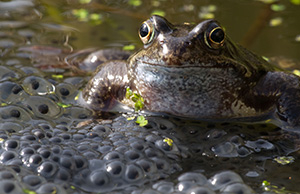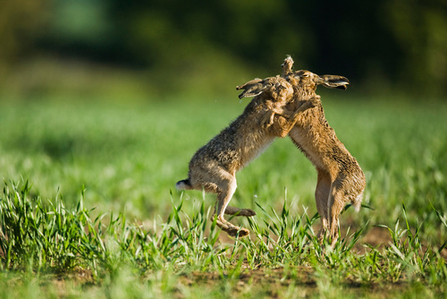Spring is a time of new beginnings, with snowdrops emerging from the winter ground, migrating birds arriving and trees coming into bud - it's a wonderful time of year!

Look out for the following signs of spring, either near your home or on one of our nature reserves -there's so much to enjoy.

Frog and spawn by Ray Dale
Frogspawn: Frogs lay up to 5000 eggs in a mass of jelly at this time of year. Look for spawn in ponds, ditches and slow moving streams. Tadpoles take about 1 month to emerge and 11 weeks to form into frogs. Toad spawn differs from frog spawn in that it forms long strings and frog spawn is one mass of eggs.

Rook by Margaret Holland
Rooks: Look and listen for rookeries up in the tree tops. Rookeries are prominent clusters of large nests in the tree tops. You are likely to hear the rooks' cacophony of loud calls and see the large black birds flapping about. Rooks will be busy collecting food for their young around this time of year. You will know they have young if you spot a rook with a swollen gullet full of food. Rooks collect and bury acorns in the winter and can remember the exact locations of acorn stashes come the spring.
You can tell a rook from a crow by the feathers on their faces. Rooks have a bald area surrounding their beak, whereas a crow has a more feathery face. Crows also nest in pairs and are usually solitary, whereas rooks are social and form rookeries.

Hares boxing by Elliott Neep
Hares: An evening walk across farmland at this time of year is likely to reward you with the sight of a hare, or even a pair of hares battling. These fights are in fact not a pair of males, but usually a female attempting to fight off a male she doesn't want to mate with. As female hares are larger than males, she will usually win, and gets to choose a more attractive partner.

Wheatear by Derek Moore
Migrant birds: The wheatear spends the winter in tropical Africa and then travels in the UK in the spring to breed. Sand martins are another early migrant, look out for their pale underneaths with a brown chest band. March is a good time to see chiff chaffs, as more arrive from Europe and Africa at this time of year. Some chiff chaffs do over winter in Suffolk, but many migrate south for winter. Listen for their distinctive 'chiff-chaff' calls. You may also see the first swallows arriving towards the end of March, after their epic journey from South Africa, travelling 200 miles a day.

Hazel catkin and flower by Malcolm Storey
Early spring flowers: Look carefully and you will see some tiny and unusual flowers at this time of year. Catkins form on hazel and alder, which are the male part of flowers, as well as the tiny red female flowers of the hazel, and cones of the alder. Look in woodland edges and hedgerows for the tiny purple or white flowers of sweet violet. Also the green shoots of bluebells start emerging around this time, although they don't flower until April or May.

